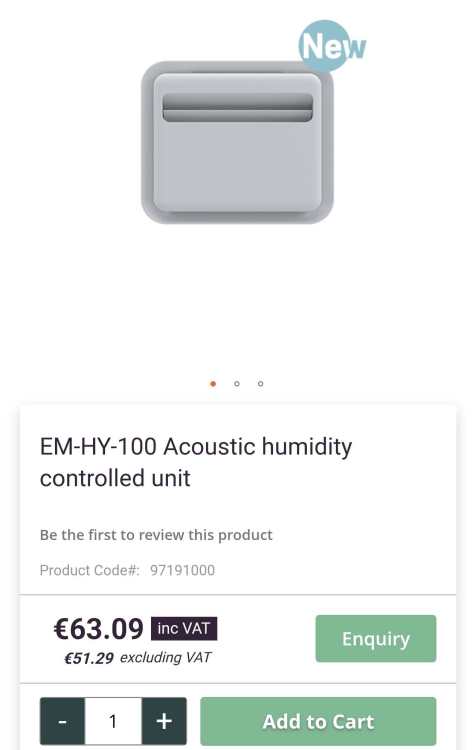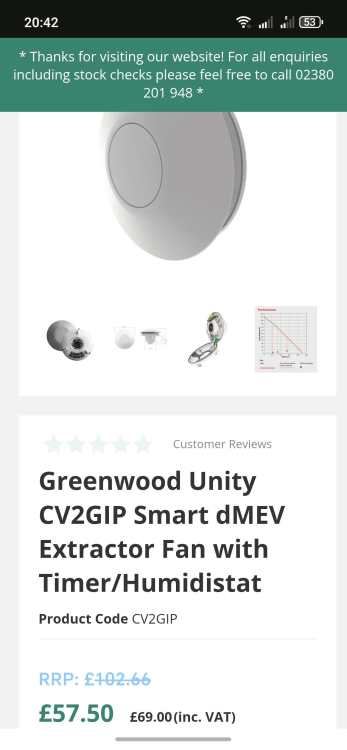-
Posts
4297 -
Joined
-
Last visited
-
Days Won
31
Everything posted by Iceverge
-
Wall mount. Or make a raised floor for the MVHR oN rubber feet or springs or hang from the rafters. Otherwise the vibrations on the joists will annoy you. No, exhaust condensation is taken care of by a drain under the heat exchanger inside the unit. Long term maybe better. You could put MVHR cowls where made most sense for the system then .. Add another roof hatch somewhere else? A cheap one that you can just tape up to air seal once the unit is in place. Otherwise there's slimmer MVHR units available. Flexi pipework is woefully compromised. Stick to rigid if you can. One thing to consider is how your house will behave in a fire. If you have a fire now in a room with a fireplace is it possible that it could travel to the attic?
-
Jebus .... Recirculating loop on a PIR I imagine is the way to go.
-
55m!? Is that a typo?
-
Could do the sums on it....... 150l of DHW water heaters to say 50 deg is about 7kWh. 30m of 22mm looped pipe and a room temp of 20deg and a water temp of 50deg is a heat loss of 250w. Say you run it 24hrs a day and you get 6kWh. Put it on a timer or a PIR sensor and you'd probably half it. Of course you might have less flushes in the first place. Your mileage will vary. I reckon it's still nothing compared to running a 10mm pipe run radially from the UVC. Will do sums later ...
-
Should I be concerned about this roof?
Iceverge replied to Whats the crack's topic in Roofing, Tiling & Slating
My fear is that a gale would send those tiles to the next parish but I suppose it's not as windy where you are. A vent in the fire would be a good start. Others any rain or damp that finds its way in will never dry out.- 1 reply
-
- 1
-

-
I was being frivolous. Suggesting it might be less hassle to just use more energy to stop the ASHP cycling like Tadje Pogaçar on Alpe d'Huez rather than chucking it entirely.
-
I meant in the winter........ Save the heat pump having to cycle...
-
You could just have put the MVHR on summer bypass!
-
If you're set on crimp fittings and mlcp I'd run 12mm to everything hot except showers and baths and maybe the kitchen tap in a radial fashion. Colds can be Teed off within a room and 16mm. You shouldn't need 20mm pipes unless you have a gravity system. A hot fill for the cistern could easily dump 150l per day of DHW down the bowl for a family. It's be less wasteful to just run the tap while you used the toilet until its hot. However....just use Hep2O. Don't insulate anything apart from the hot at the cylinder, it's a waste of time. I have a thread about my woes somewhere.
-
Why the change from your 6kW unit?
-
EPS can soak water but that's typically only when fully immersed and then worst case is only 5% or so. The amount wicked up by capillary action from damp ground is typically negligible as the capillary network between the EPS beads is far larger than brick or soil. If you're concerned, a capillary break like a shovel of gravel below the EPS would certainly solve it. On the other hand if you have some XPS to hand that would work equally well in this situation if it has sufficient compressive strength.
-
Get some EPS200 and wedge/hammer it down until it hits something solid. Make sure you don't block any ventilation for the floor. Foam it in place with illbruck FM330. Trim the top of the EPS flush with the top of the joists. Stick the plywood to the top of the EPS with stixall or CT1. Apply masking tape to the door and floor before you do this as the foam and sealant will be hard to clean off.
-
Bloody tired of being confused. What heating system to fit ?
Iceverge replied to Big Jimbo's topic in Other Heating Systems
I'm feeling some what validated in my choice to avoid central heating entirely. -
Bloody tired of being confused. What heating system to fit ?
Iceverge replied to Big Jimbo's topic in Other Heating Systems
There's something to be said for building the first house as close as possible to the spec of the house you want to live in. You'll be more lightly to get it right second time around. The new owners will be next door neighbours. You don't want to piss them off by: 1. Building to a really crappy standard 2. Including gizmos that non Buildhub nerds will never bother to understand and thus fail to maintain. A monoblock ASHP + UVC isn't more complex than a boiler in my view. Just get one with an simple control system. Basically every new build in Ireland has one with a decade and people seem to be coping. Then again I don't think "big oil" own quite as many of our news men spreading the the FEAR!!! MVHR is nice for comfort but economically it's not cheaper than dMEV once you take servicing and filters into account. You'd have a very respectable zero maintainance dMEV system for less than £1000 installed cost. No ducting etc required. Why not UFH upstairs too? Is it much dearer? Could be a good selling point. Better still, don't install it but just tell them you did. In a well insulated house they'll never notice the difference. Solar I would do the minimum for SAP. Airtightness and insulation I would maximize my efforts. Pay attention to good sound insulation too. You never know, Black Sabbath could buy the house from you. -
I had to recess the mounts for my MVHR terminals. I just ran a piece of OSB between the joists on battens. The bottom face of it was about 50mm above the lower face of the joists. I folded my airtight membrane up and taped it to the OSB .
-
Damp Bungalow
Iceverge replied to Potatoman's topic in Mechanical Ventilation with Heat Recovery (MVHR)
Suck out of your can. Replacing bathroom fans with dMEV like John said is the easiest and cheapest. You probably have loft space for a centeralised MEV system or maybe even a MVHR if you want to go all in. -
150mm Composite deck screed alternative
Iceverge replied to bmj1's topic in General Structural Issues
I feel being trickle fed details here is limiting how much we can help. Can you please give us a size and scale of the building. I had in my head it was a 4x4m prayer room initially but portal frames etc suggest it may be 40m X 40m. How much work has been done. What's under the floor? A house? Offices? A car park? Heating it from 6am until 11pm means a lot of energy so investment in the fabric is vital. This means insulation airtightness and mechanics ventilation. What's the approach here? Have the structural details been finalized? Direct electric UFH is of course 100% efficient like any reistive heater but heat pumps can often be "300%" efficient. It might not be an ideal fit for your building though depending on your insulation and the ability to control ventilation through public use of doors etc. Like I say more details = better advice. -
OSB3 as VLC in warm wall construction over oak frame
Iceverge replied to David Cooke's topic in New House & Self Build Design
That would work fine. U value won't meet regs though. What kind of rain screen are you planning on ? The vapour permeability of the OSB is a bit mute when you have foil faced PIR outside of it but it will work as an air control layer which is much more important than vapour control. With a 125x50 TF external to the oak frame you're building 2 houses though but that always seems to be the issue with oak frames. I think @Post and beam used SIPS. As an idea you could spec an I-Joist structure to balloon frame over the oak with an external airtight layer like @IanR. With the Oak taking most of the structural loads it hopefully could be quite minimal. Full fill with cellulose then. -
Have a close look at the picture above. It's what I suggested for the roof. ( Although you could do the whole house) It's from the "monopoly framing" system by Matt Risinger on YouTube. It's a really great concept for air sealing and dealing with thermal bridging in complex house shapes, it's not mine. I rarely have original thoughts! The timber frame is built with no bits sticking out. Then air sealed externally. In this case taping the sheathing. Then any overhangs are added and finally a layer of PIR or maybe Rockwool/woodfiber. Finally the external cladding. Air sealing from outside is dead easy on a timber frame building like this. 10 times easier than doing it inside. Likewise an unbroken layer of external insulation is simple to do and really performs excellently. I would be happy to tape 11mm OSB as an airtight layer so long as you could avoid rain until it was covered.
- 77 replies
-
- flat roof
- condensation
-
(and 2 more)
Tagged with:
-
We had a separate DPC on the external leaf 150mm above external ground level. There's no need for a tray here. Just let the EPS beads fill to the bottom of the cavity.
- 77 replies
-
- flat roof
- condensation
-
(and 2 more)
Tagged with:
-
Just saw now. Will have a look shortly.
- 77 replies
-
- flat roof
- condensation
-
(and 2 more)
Tagged with:
-
I would get this right before going anywhere near a heat pump. I would rather chew my leg off than put PIR in a cavity wall or between roof timbers. Why the combo of EWI and cavity in the new build? I would do one or the other. Why so little EWI? The insuation is a small cost vs the install and render. Wait.........do hear a greasy haired white toothed kingspan salesman boarding a plane..........I think he's off to Marbella for a jaunt on the kooltherm sales he pawned off to you via your architect......
- 39 replies
-
- 2
-

-

-
- mvhr
- ashp and dhw
-
(and 2 more)
Tagged with:
-
Wooden subfloor with 4 inch joists and rockwool
Iceverge replied to Rocket Ron's topic in Heat Insulation
Then you'll have a breeze blowing around the sides of the PIR freezing your floor. Or you'll have a breeze blowing around your bank vault where your bullion used to be that you had to liquidate to spend on gapotape. -
Get the best match you can. Dry lay them. See if you can tell the difference. If you can rip up the rest of the old tiles and finish it with the new tiles.
-
Tape them up and all is well!




